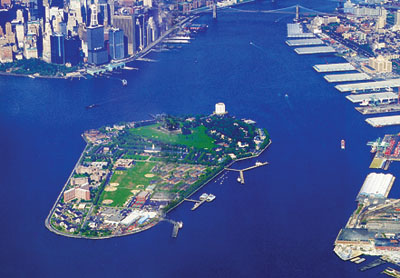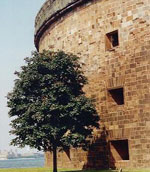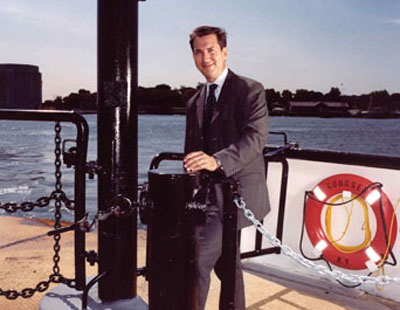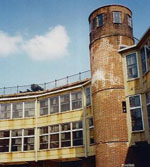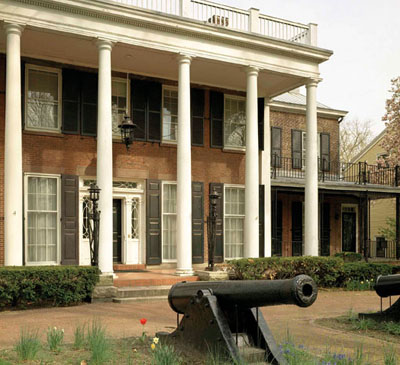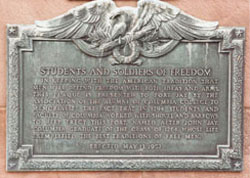|
|
 |
 |
 |
 |
|
FEATURESSo Near and Yet So FarJim Lima ’85 heads New York's effort to put Governors Island back on the mapBy Charles Butler ’85
Think of lower Manhattan for a moment. What comes to mind? Sure, Wall Street and Mott Street. the Brooklyn Bridge, the Woolworth Building, the Staten Island Ferry and, sadly but undoubtedly, Ground Zero. Keep mulling the sites, though. Is there anything else you can pick out — say, Victorian homes that rival those of Cape May? Or, a U.S. Army fort whose barricades once held an AWOL Rocky Graziano? Or, a golf course where tee shots soar into a Hudson River backdrop only to come down on fairways far from honking horns and pushcart vendors? Is that the lower Manhattan you’re used to picturing? Not likely. But Jim Lima ’85 knows such a place exists. The challenge: getting others to know. The place is Governors Island, the 172-acre strip in New York Harbor with enough history — and, in Lima’s view, plenty of promise — to be the next great Big Apple attraction. In the summer of 2003, Lima was named president of the Governors Island Preservation and Education Corp. (GIPEC), a state- and city-run agency with the mandate to redevelop the all-but-abandoned island. For nearly two centuries, the government owned the island, using it as an Army base before the Coast Guard took control in 1966. But in 1996, the Coast Guard left the island, leaving it virtually unoccupied and dormant, until President George W. Bush transferred rights to the island, for $1, to New York in January 2003.
Technically, the island is part of Manhattan, though you’ll need to take a five-minute ferry ride to get there. And, right now, access to the island is only beginning to open up. This past summer, GIPEC and the National Park Service offered about a dozen guided tours per week; in addition, visitors could roam a one-mile stretch of the island’s esplanade on Saturdays. It’s Lima’s job to accelerate that, turning this desolate stretch into a draw, rivaling Liberty Island, Ellis Island and every other New York City attraction, for visitors’ time, attention and spending dollars. “There is a remarkable lack of awareness. Most dyed-in-the-wool New Yorkers know nothing about this place,” Lima, 40, says one afternoon at a South Street Seaport restaurant, looking through plate-glass windows toward the island. “Even if they know of it, they haven’t been there.” Still, he adds, “They are amazed when they walk onto it.” You bet they are. A few weeks later, Lima takes a couple of first-timers on a private tour of the island. The visit is like opening a history book, one untouched for years, and discovering pieces of America’s and New York City’s past. For example, just 50 or so yards from the island’s dock, Lima walks you to the entrance of Fort Jay. On this winter day, the fort is empty, cold and gray. But when it was built, in the late 18th and early 19th centuries, Fort Jay was a strategic outpost for troops who would later fight in the War of 1812. Its name comes from John Jay (Class of 1764), who went on to, among other things, help negotiate the Treaty of Paris in 1783, which formally ended the Revolutionary War, and, in 1794, the Jay Treaty, which was intended to iron out remaining differences between the United States and Britain. Unfortunately for Jay, many of his compatriots felt that the latter treaty lacked much bite; his reputation subsequently took a beating and his namesake fort took on a new designation: Fort Columbus. Only a 1904 proclamation from President Theodore Roosevelt got “Jay” back on the fort.
Attached to Fort Jay’s gateway is a plaque, presented in 1952 by the College Alumni Association, honoring Columbia students and faculty members who were involved in its construction. In part, it reads, “In keeping with the American tradition that men will defend freedom with both ideas and arms, this plaque is presented to Fort Jay … to memorialize the fact that in 1794, students and faculty of Columbia worked with shovel and barrows to help erect this fort. Named after John Jay, Columbia graduate of 1764, whose life exemplified the best traditions of free men.” In fact, Columbia’s connections seem to run deep throughout Governors Island. Lima says there is some evidence that King’s College, in the late 1770s, considered moving from its location near Trinity Church to the island. “I’m still looking for the documentation, but that appears to be the case,” Lima says. Lima next takes the visitors to a quad where 13 Victorian homes, painted a quiet yellow, are grouped in a horseshoe. These are the officer homes, built around 1880. And while they could use a visit from fix-up master Bob Vila, the visitors consider their stylish facades with front-porch views of New York Harbor and wonder what they would go for on the open market.
The group walks a few feet to a neo-Gothic church and Lima opens the musty but still magnificent chapel of Saint Cornelius the Centurion, which was built in 1905 and is the successor to a similarly named chapel erected in the 1840s. Credit for the original St. Cornelius, Lima says, goes to the Rev. John McVickar. In the 1840s, when he was the Governors Island chaplain and a Columbia professor, McVickar convinced Trinity Church to fund its construction. And today, as Lima points out, “Trinity Church owns St. Cornelius Chapel. We own the land under it. It is the only building we don’t own [on the island].” Of course, there are some less sacred secrets. At one point, while walking through the island’s other fort, Castle Williams, which, like Fort Jay, was built nearly 200 years ago but later became an Army prison, Lima notes, “It’s rumored that Rocky Graziano, the welterweight boxer, was locked up here after going AWOL during World War II.” Lima also points out that songwriter Burt Bacharach was stationed on the island in the 1950s and played piano in the G.I. Officers’ Clubs for servicemen, and that the Smothers Brothers, Tom and Dick, were born there when their father was stationed on the island. Lima saves a favorite fact for the back of the island, whose foundation is made up of landfill from the construction of the old Manhattan Third Avenue “el” train. “Over there is a bowling alley that had a Burger King,” Lima says. He pauses a moment, then with a sly smile adds, “which was one of the few in the world that sold beer.”
Clearly, Governors Island has nooks and crannies filled with great trivia. But Lima wants the island to have a present and future, too. And he’s using his arsenal of experience, from nearly 20 years of studying and executing urban-design plans, to shape Governors Island so that it’s a top-of-mind destination for business executives, educators and tourists. The trick? Doing it in a way that’s in line with the island’s new charter. “There is no question the land would be valuable as real estate if we could build luxury housing or a casino — things you could do to generate a lot of money,” he says. “But part of getting the island for $1 for the people of New York was agreeing to legally binding deed restrictions that prohibit permanent residential, casino and industrial use and a number of other things.” That said, Lima is putting together his dream scheme of activities and attractions that would provide the revenue needed to offset the costs of maintaining the island. Considering the island’s proximity to Wall Street, he pictures a major hotel chain operating world-class meeting venues that could host economic conferences in the scope of the World Economic Forum in Davos, Switzerland. He envisions universities holding educational conferences and tapping into the island’s historic and environmental links. He tosses out the idea of getting a philanthropic organization to develop a youth-oriented golf program that would make use of the 9-hole executive course built just a chip shot from Fort Jay. “Safe to say,” Lima points out, “it’s the only golf course with a Manhattan ZIP code.” (One hitch to that plan, however, is that the course is part of a 20-acre area, which includes Fort Jay and Castle Willams and is overseen by the National Park Service, not GIPEC.) And he’s thinking of ways to entice concert promoters and theater groups to stage events on the island.
“Once we tap into the tourist market, we’ll get people out here who will have a range of things to do — go to an ecology center, a military museum or a theatre performance, take a bike ride around the island or go to a spa that supports a meeting facility.” Lima pauses as visitors consider the novelty of a spa in New York Harbor. “Why not?” he says. “Why go to Tucson when you could go right here?” Throughout his time in New York City as a Columbia student and then as an official involved in various housing and development projects, Lima has been driven by the potential in the city’s different pockets. A native of Tiverton, R.I., where he helped run his father’s restoration contract business while an undergrad, Lima majored in architecture and urban studies and later completed a master’s program in real estate development. “I spent a lot of time in Avery Library,” he says with a laugh. Among his professors, Lima points to Gwendolyn Wright, an architectural historian and host of the recent PBS series History Detectives, for “inspiring me to think about ways to continue to improve cities.” As such, he became an “adventuresome urbanite,” often spending his free time roaming the city and admiring its architectural mixtures. “My friends joke that I should have more broken bones in my body because I am always looking up instead of straight ahead,” he says.
Lima’s jobs have taken him to all corners of New York. He spent several years with the New York City Council’s Land Use Division on development projects in such areas as the Rockaways. Then, from 1996–2001, he was an assistant commissioner at the NYC Department of Housing Preservation and Development, which brought him front and center with some of the major new residential construction sites around the city. For a sample of Lima’s work, head up to Harlem between Madison and Lexington Avenues and 116th and 120th Streets. In recent years, new contextual multi-family housing units have been constructed, stylish but affordable. “It was said that we couldn’t build multi-family housing up there, that the financing wouldn’t work. We found a way to make it work,” Lima contends. “They said retail wouldn’t work. We insisted on it so the streets would be lively and safer and provide more services. And there has been real success.”
In 2002, Lima became senior v.p. for special projects at the NYC Economic Development Corp., and in July 2003, Mayor Michael Bloomberg tapped him to oversee Governors Island. In announcing Lima’s appointment, Bloomberg said, “Since President Bush, Governor [George] Pataki and I announced last year that the people of New York have regained possession of Governors Island — the ‘Crown Jewel’ of New York City’s harbor — Jim has worked tirelessly to ensure the island will be used for the greatest possible public benefit. His firsthand experience, coupled with his leadership skills, wealth of expertise working on complex projects throughout the city and talent for consensus building, will prove invaluable to Governors Island’s future.” While Lima calls it a “dream job,” it’s one that’s evolving. At times, he is a design facilitator, working with potential architects and planners outlining future redevelopment projects. At others, he is a fund raiser, looking for the financial connections that will make his grand ideas real. And at others, he’s an old-fashioned tour guide who needs to make do when the unexpected happens. One day in August 2003, shortly after landing the job, Lima took a group from the President’s Advisory Council on Historic Preservation to the island for an inspection. As the tour wound down, a glimpse from the island to the mainland left little doubt something was up: The great Northeast Blackout had commenced.
“Most of the people in the group were from out of town, and they said, ‘Can we stay out here?’ ” Lima recalls. “The guys from the firehouse had us over for a barbecue. We had an amazing afternoon, and we watched as the sun went down behind the Statue of Liberty.” As relaxing as that moment may have been, Lima admits his biggest challenge may be staying patient as he begins bringing this lost land into the 21st century. He’s moved himself and his seven-person staff into permanent space in one of the island’s arsenal buildings. This past summer, he booked several corporate events on the island as well as an evening of free outdoor short films shown on the island’s parade grounds, which attracted nearly 1,000 people. And by the fall, he expects to have the island’s seven ball fields and one soccer field, left over from the days when more than 4,000 people lived there, back in play and available for the city’s recreational leagues. The long-range goals — contracting with hotel operators and signing up major donors — will take longer, and come as the city moves forward with the Ground Zero restoration project. “We need to understand that at some time, 6–8 million people a year are going to come to the World Trade Center Memorial, and they are going to be looking for other things to do. We want to be a must-see destination in lower Manhattan,” he says.
For that to happen, Lima adds, “Every place needs something iconic about it, a postcard image. Right now, we don’t have one. But that is the exciting design solution ahead of us. There are many exciting problems to solve in ways that we haven’t begun to determine. We want to be innovative and creative, and we want design excellence.” Lima finishes his coffee and looks back at the island bathed in late afternoon sun. Then, he says, simply, “We need to create some buzz.” For more information on GIPEC, please visit www.govisland.com. Charles Butler ’85 is a features editor with Runner’s World magazine in Emmaus, Pa.
|
|
|||||||||||||||||||||||||||||||||||||||||||||||||||||||||||||||||||||||||||||||||||||||||||||
